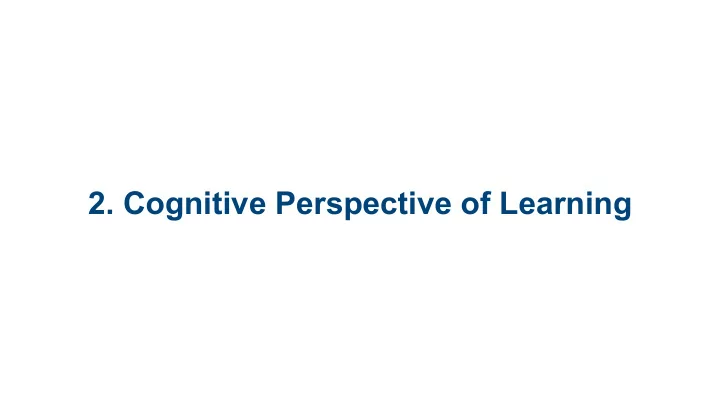

2. Cognitive Perspective of Learning
Cognition: Big Questions • How do things “out there” become knowledge in us? • How does the brain make learning possible? • What analogies can describe those brain processes? • How can teachers use all this to enhance learning?
Cognitive Perspective • Analogies/models to explain how information is processed into learning • Sequence: external stimuli ➔ senses ➔ brain ➔ knowledge • Brain assimilates and stores knowledge
2.1 Sensory Register 2.2 Working Memory 2.3 Long-Term Memory 2.4 Teaching Strategies 2.5 Forgetting
2.6 Problem-Solving 2.7 Teaching for Transfer 2.8 Metacognition 2.9 Summary
2.1 Sensory Register
Sensory register Brain areas receiving raw sensory input • iconic = for visual input (occipital lobe) • echoic = for auditory input (temporal lobe)
Attention Act of focusing/filtering input • Sensory input is constant, changing, and vast • From earliest age, brain learns to filter and attend to small portion of input
Perception Act of labeling input • You receive patterns of light/dark, color, shape • You perceive your friend approaching • Between reception and perception – many brain processes!
2.2 Working Memory
Working memory Also “short-term memory” • Like computer RAM (temporary storage before processing) • Capable of storing few bits of information • Size of bits can be enlarged by chunking (5-7 items per chunk)
Rehearsal Prevent loss of working memory contents • Maintenance rehearsal = rote/repetition (least effective for memory) • Elaborative rehearsal = encoding by activity or by relating to previous knowledge
Other working memory functions • Automaticity = memory more efficient when part of well-known routine • Encoding = memory assimilated with previous knowledge • Encoding leads to personal perception
2.3 Long-Term Memory
Long-term memory Like computer hard drive (permanent storage) • Semantic = facts and information • Episodic = experiences and events • Procedural = “how-to”
Schemata (plural) Organizational metaphor • Like folders on computer screen to show contents • Schema = concept or category (e.g. “dog”) [like document folder] • Subschema = sub- category (“poodle dog”) [like subfolder in folder]
In the cognitive perspective … • Learning = (re)organizing schemata based on new information/experience • New behavior will follow incorporation of new learning
2.4 Teaching Strategies to Enhance Learning at Each Stage of Information Processing
Teachers help students attend retain retrieve
Help students attend • Emphasis on focus/ attention • Filter out distractions • Focus on detail, similarities, differences, etc.
Help students retain Engage memory processing • Organizing/sequencing lessons • Use of many senses • Novelty • Drill and practice • Mnemonics, rhyming, analogies
Help students retrieve • Reminding about mnemonics and practice exercises • De-stress and de-clutter mind and environment • Periodic review and practice
2.5 Forgetting
Prevent forgetting? 1 Inability to retrieve from long-term memory • Cause: Memory decay from disuse ➔ review or use memory • Cause: Stress (release of hormone epinephrine) ➔ calm, breathe to activate serotonin release
Prevent forgetting? 2 • Cause: Interference by “noise” ➔ isolation, calm • Cause: Interference by newer information • Proactive: old info interferes with new • Retroactive: new info interferes with old ➔ Cure? It depends … .
2.6 Problem Solving
Problem-solving strategies • Identify, define, explore, anticipate, look (IDEAL) • Means-ends analysis • Identify relevant/essential information needed • Graphic representation
Problem-solving ability • Cognitive stage/maturity • Creative vs. rigid mindset • Ability to brainstorm unusual ideas • Ability to use heuristics • Ability to work backward
2.7 Teaching for Information Transfer
Types of transfer • Positive ➔ Previous knowledge helps new • Negative ➔ Knowledge gets in way of new info • Specific ➔ Direct use of old knowledge • General ➔ Indirect use (relies on g factor of general intelligence)
Teaching for transfer • Help students see practical applications of new knowledge • Provide activities to use new knowledge • Provide problem-solving activities (well and poorly defined)
Why teach transfer? • Affects how students learn new things in future • Affects future problem- solving • Affects how cognitive skills differentiate from general to specific
2.8 Metacognition
Thinking about thinking Teachers provide strategies and practice for efficient learning, e.g. • Goal setting • Time management • Creating mnenomics • Chunking • Note-taking
Why teach strategies of metacognition? • Helps learners take control of their learning • Learners choose which strategies work best (customize) • Builds confidence and “can-do”
2.9 Summary
Cognitive summary 1 • Brain science uses analogies/models to map the thinking processes • Science reveals how learning can be helped and hampered • Teachers use this to make learning more efficient and effective
Cognitive Summary 2 • Teachers use strategies that help students attend, retain, retrieve • Teachers help students by teaching them effective strategies • Teachers help students learn to use/transfer knowledge
Recommend
More recommend